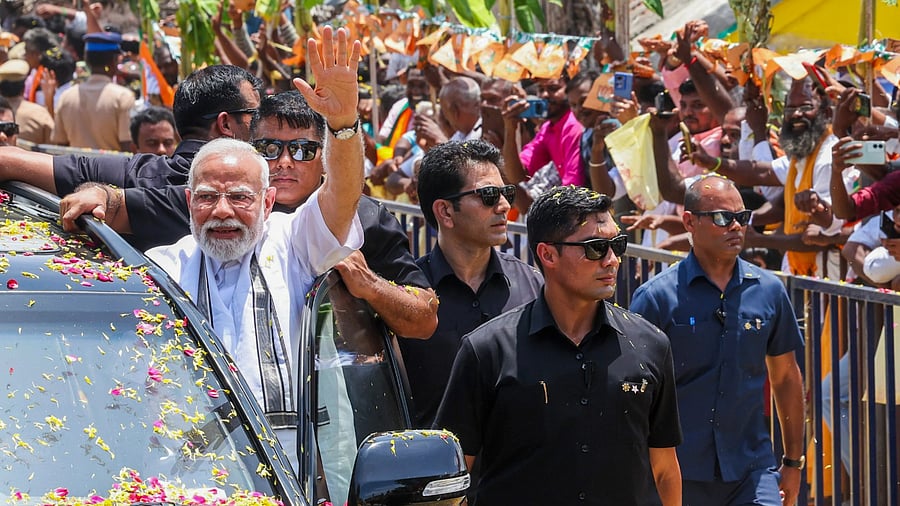
Prime Minister Narendra Modi during a roadshow at Gangaikonda Cholapuram in Ariyalur district of Tamil Nadu.
Credit: PTI File Photo
Chennai: On July 27, at Tamil Nadu’s Gangaikonda Cholapuram temple, a beaming Prime Minister Narendra Modi expressed joy at having brought Gangajal (water from the Ganga) once again to the erstwhile capital of the famed Chola empire.
Modi’s act not merely mirrored Emperor Rajendra Chola’s achievement — Around 1,000 years ago, the mighty emperor had brought the Ganga water to consecrate Gangaikonda Cholapuram after conquering the Gangetic plains — but was also intended to deliver messages of unity and that Tamil Nadu’s glory and its people’s identity are deeply rooted in Hindu traditions.
However, Tamils have generally avoided wearing their religion on their sleeves.
The Prime Minister’s sojourn to Tamil Nadu — he is likely to visit the renowned Thillai Natarajar temple in Chidambaram later this month — is more than just a cultural or religious assertion. It is part of the BJP’s concerted effort to win over the Tamil community by shifting the narrative away from Dravidian ideology, whose adherents — DMK and AIADMK — have dominated the state's political landscape since late 1960s.
Having realised that language and culture are vital tools to connect with Tamils, the saffron party has been carefully structuring its political discourse in Tamil Nadu by showcasing that it takes pride in the Tamil language and the rich cultural identity of Tamils.
While Modi is personally fascinated by the Chola empire’s naval prowess and deep commitment to upholding the Shaivite tradition, the former kings are yet another weapon in the BJP’s arsenal to woo Tamils.
Not only that, the BJP, as far back as 2015, made a conscious effort to broaden its base by reaching out to seven sub-sects of Dalits and endorsing their demand to be recognised as Devendra Kula Vellalars. It has also attempted to win over the entrepreneurial Gounders — BJP’s former TN chief K Annamalai hails from this caste.
However, every effort — be it political, cultural, or linguistic — veers off the runway when the BJP takes up its pet topics of religion and Hindi, a language that is still alien to a majority in the state.
BJP’s efforts to make Lord Murugan — one of the most revered deities in the state — its poster boy didn’t yield any electoral dividends. Moreover, the party raking up the presence of a dargah at Thiruparankundram hills, where a famous Murugan temple is located, failed to resonate with locals, who responded with a stern message: "We have been coexisting for centuries."
Despite this, the party continues to flirt with religious identity. This raises a pertinent question: Is the party only consistent in its inconsistency? Or is it confused about its strategy vis-à-vis Tamil Nadu?
While the Modi government claims it has showered funds on TN since 2014, actions like withholding funds for not enforcing the three-language formula and advocating Hindi help the DMK’s narrative that the BJP wants to impose Hindi.
"Whatever Prime Minister Modi and his government are trying to do to impress the Tamil people is being undone by some actions. People are confused. It is not just that their words don’t match their actions, but they directly support the DMK’s case against them," senior journalist R Bhagwan Singh told DH.
Many of the BJP’s efforts to win over Tamils before 2016 were derailed after the party began intervening in the internal affairs of the AIADMK after the death of J Jayalalithaa.
In the melee, the BJP failed to gauge the growing resentment against it. In fact, Modi faced significant protests, both offline and online, in Tamil Nadu during the 2019 polls when his popularity was at an all-time high elsewhere in the country.
However, anti-Modi sentiment was reversed to some extent with continuous efforts by the BJP especially after Annamalai took over in 2021.
The NDA did score an impressive 18% vote share (BJP 11%) in the 2024 polls — though it didn’t win seats — due to its success in stitching together a rainbow alliance, sans AIADMK.
This move helped the NDA push the AIADMK to the third position in many constituencies in southern Tamil Nadu. But again, the BJP’s decision to revive its alliance with the AIADMK for the 2026 polls might negate the gains, though this might help it bargain for more seats.
Prof Ramu Manivannan, who taught political science at the University of Madras, identified the BJP’s desire to emerge as an ideological alternative — not a political alternative — to the Dravidian narrative as the reason for it not making any headway.
"The BJP wants to emerge as an alternative to the AIADMK first and then shift the narrative away from Dravidianism. They want a major shift. If they attempt to emerge as a political alternative, maybe, they can make significant inroads. Ideology-wise, TN will never concede to or accept the BJP as an alternative,” Manivannan said.
He further said the BJP is overwhelmed by the Dravidian narrative in Tamil Nadu and noted that the nature of politics here is very different from a state like Karnataka, where it could become the governing party.
"Politically and culturally, the Dravidian narrative is entirely different. The BJP is challenged more in Tamil Nadu than anywhere else, especially when it comes to language. Making political inroads in TN is an uphill battle for the BJP because it can shift the goalpost anytime. The BJP can never provide parity for Tamil with Sanskrit," he added.
According to Singh, the BJP should not just invest in themes but also in strengthening party infrastructure and booth-level presence. “The BJP should understand that a one-man army, led by Modi, will not suffice to take on Dravidian politics, which not only boasts of its own glory but also projects the BJP as the villain by calling its politics and policies alien to the state,” he said.